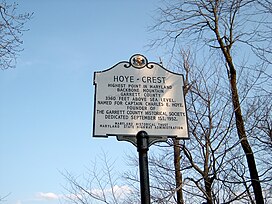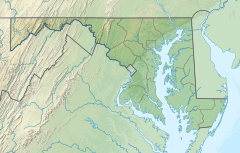| Hoye-Crest | |
|---|---|
 Marker at Hoye-Crest, the high point of Maryland | |
| Highest point | |
| Elevation | 3360+ ft (1024+ m) NGVD 29[1] |
| Prominence | 80 ft (24 m)[1] |
| Parent peak | Backbone Mountain |
| Listing | U.S. state high point 32nd |
| Coordinates | 39°14′14″N 79°29′07″W / 39.237329°N 79.4853308°W[2] |
| Geography | |
| Parent range | Allegheny Mountains |
| Topo map | USGS Davis |
Hoye-Crest is a summit along Backbone Mountain just inside of Garrett County, Maryland. It is the highest natural point in Maryland at an elevation of 3,360 feet (1,020 m).[3]
The location, named for Captain Charles E. Hoye (1876–1951), founder of the Garrett County Historical Society, offers a view of the North Branch Potomac River valley to the east. The Maryland Historical Society placed a historical marker at the summit during a dedication ceremony in September 1952.
Accessing Hoye-Crest[edit]
There is no vehicular access to Hoye-Crest. The best route by foot is a hike along the Maryland High Point Trail, from a point along U.S. Route 219 just south of Silver Lake, West Virginia at 39°14′43″N 79°29′30″W / 39.24528°N 79.49167°W. The trail ascends Backbone Mountain along an old logging road on Monongahela National Forest property to the West Virginia-Maryland state line. The distance is about one mile each way. The trail then heads north along the state line to the high point. Hoye-Crest sits on private property (Western Pocahontas Properties), though access is permitted.
See also[edit]
References[edit]
- ^ a b "Backbone Mountain, Maryland". Peakbagger.com. Retrieved 2012-11-08.
- ^ "Hoye-Crest". Geographic Names Information System. United States Geological Survey, United States Department of the Interior. Retrieved 2012-11-08.
- ^ "Backbone Mountain". SummitPost.org. Retrieved 2008-06-02.
External links[edit]
- "Backbone Mountain". SummitPost.org.

Well, that’s interesting to know that Psilotum nudum are known as whisk ferns. Psilotum nudum is the commoner species of the two. While the P. flaccidum is a rare species and is found in the tropical islands. Both the species are usually epiphytic in habit and grow upon tree ferns. These species may also be terrestrial and grow in humus or in the crevices of the rocks.
View the detailed Guide of Psilotum nudum: Detailed Study Of Psilotum Nudum (Whisk Fern), Classification, Anatomy, Reproduction